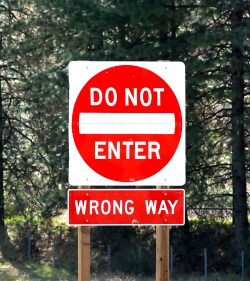
According to a recent study, those who drive the wrong way on roads throughout Texas cause more car accidents here than in any other state in the country. The Texas Department of Transportation (TxDOT) is well aware of the problem, and they have been working on possible solutions to this serious problem.
So far, the state has installed motion-activated signs at dozens of locations throughout the state that light up when drivers enter an off-ramp and start driving the wrong way on a highway. That is because most wrong-way accidents happen on highways when drivers do exactly that. These types of accidents are especially common at night, when drivers might be unable to clearly see whether they’re entering a highway the wrong way.
Perhaps not surprisingly, many of these nighttime wrong-way drivers who cause accidents are over the legal limit for Blood Alcohol Concentration (BAC), which is .08 percent in Texas and everywhere else.
This past Sunday, police in Benton, which is located in Central Texas, reported that one person was killed and another was seriously injured in a wrong-way car crash on Southbound Interstate 35, near Exit 287, for Amity Road. The crash happened at about 9:30 p.m. and all traffic was diverted from the southbound side of the highway to a nearby access road. One person was killed in the accident, although police did not make any details available, while another person was transported to Baylor Scott & White Health for unknown injuries.
How Texas Drivers Can Help Reduce Wrong-Way Accidents
The most obvious method for drivers in Texas to avoid wrong-way accidents is to always pay close attention while driving, especially when they are about to enter a highway via a marked exit. There are plenty of signs, so if the driver is paying attention, they will likely avoid such a mistake.
Drivers should also obviously avoid distractions while driving. Put away the cell phone and other electronic devices and concentrate solely on operating their vehicle. This would be safer for them, but it would also be safer for everyone who drives around them, even if they’re not driving the wrong way. Of course, paying closer attention will make them less likely to drive the wrong way in the first place.
Another important step is making sure you drive sober. Texas leads the nation in fatal drunk driving accidents. More than 40 percent of all fatal accidents in Texas in 2014 occurred due to drunk drivers, according to the National Highway Transportation Safety Administration (NHTSA).
What Texas Officials Can Do to Reduce Wrong-Way Accidents
One study from a few years ago compiled the following data on Texas wrong-way crashes:
- These crashes were five times more likely to occur between 12:00 to 5:59 a.m. than at any other time of day, with the most frequent time for wrong-way crashes being the 2:00 to 2:59 a.m. hour. That closely corresponds to the closing time of most Texas bars.
- Approximately 50 percent of wrong-way crashes resulted in an incapacitating injury or fatality, a number that is significantly higher than the proportion for all other types of crashes.
- Wrong-way crashes have a serious economic impact. The total impact is nearly almost $21 million per year, based on the average cost of crashes used by TxDOT.
- Men accounted for slightly more than two-thirds of wrong-way drivers.
- Nearly half of the wrong-way drivers were under the age of 34.
- Of course, nearly 61 percent of the wrong-way drivers had some influence of alcohol and/or drugs cited by the investigating officer.
- Most collisions occurred in the inside (left) lane of the correct direction, thus showing that the wrong- way drivers are staying as far to the “right” as possible, as they normally would if they were going the right way.
While wrong-way crashes are still relatively infrequent, it’s important to remember that Texas still leads the nation in motor vehicle fatalities overall, as well as in the number of wrong-way crashes. Wrong-way crashes are also more likely to produce serious injuries and fatalities when compared to other types of highway accidents because most tend to be head-on crashes.
A number of states now use ITS applications like changeable message signs as a method for deterring drivers from entering highway exits and to warn highway drivers of the presence of a wrong-way driver.
Since the most frequent origin of wrong-way incidents is the freeway exit ramp, such movements may be deterred by adding signage and signals to exit ramps. While most states, including Texas, use standard DO NOT ENTER (DNE) and WRONG WAY (WW) signs, states who have also added WRONG WAY pavement arrows from the Manual on Uniform Traffic Control Devices seem to have fewer instances of wrong-way drivers. =
According to experts, officials should immediately repair deficient wrong-way pavement arrows and prioritize their maintenance, especially in urban districts like San Antonio. Officials should also consider lowering the DO NOT ENTER and WRONG WAY signs to something closer to eye level, to catch the attention of those who are having a hard time seeing them at night.
One other suggestion for TxDOT is to develop a wrong-way crash monitoring system and field review. The state of California has such a process and it seems to be working for them.
If you or a loved one have been injured in a wrong way accident, contact a San Antonio car accident lawyer today to review your legal options.
